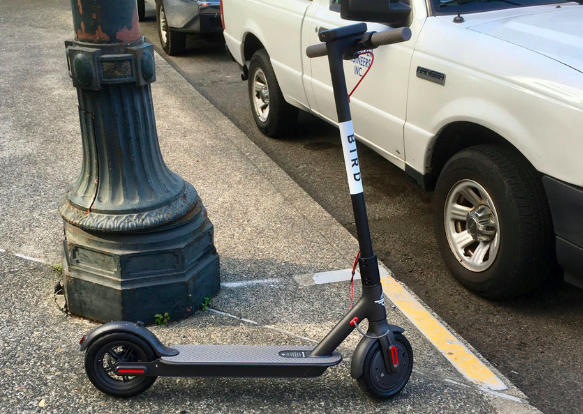If charging scooters to use city streets makes sense, let’s charge cars proportionately
A little bit late to the party, but today the first electric scooters appeared on the streets of Portland. Bird announced that, with the city’s permission, it was scattering hundreds of its electric scooters in and around the downtown. A second company, Skip, is expected shortly, and Lime is also gearing up to enter the market.

One item in the Oregonian’s announcement of the new service caught our eye: Bird will pay the city $1 per day for each scooter it operates, in order to help support the cost of road infrastructure:
Bird said it commits to: “collecting all of its vehicles each night for charging and necessary maintenance; practicing responsible growth by only adding more vehicles when each Bird averages three or more rides per day; and remitting $1 per vehicle per day to the city to build more bike lanes, promote safe riding, and maintain shared infrastructure.”
Interesting idea. As we’ve maintained at City Observatory, much of our urban transportation problem derives directly from the fact that the price is wrong: we don’t charge road users for the roadway that they use. The city is wisely asking Bird (and presumably other scooter operators) to pay in proportion to how many scooters they place on city streets. The dollar a day charge should keep them from inundating city streets with unused or underused scooters, and will provide money to maintain and improve infrastructure.
That got us thinking. What if the city imposed a similar proportionate charge on cars? Right now, the city charges almost nothing to car owners living in the city. The city collects some money from those who park at metered downtown street spaces during prime hours, and gets a portion gas taxes (though not enough to cover the cost of building and maintaining roads). Let’s imagine that the city imposed the same kind of fee on cars it charges for scooters, but made it proportional to the number, size, weight, pollution, safety impacts and value of private automobiles.
Start with a simple per vehicle fee. Suppose each car owned by a city household paid a dollar day toward the cost of building and maintaining city streets. According to the American Community Survey, Portland households own about 380,000 private vehicles. If they each paid a dollar a day toward the cost of city streets, that would work out to about $365 per day, which is more than triple the amount of money that the State of Oregon (not the city) charges as an annual vehicle registration fee. (This would provide $140 million annually for city street expenditures).
We should also consider the vehicle’s safety and environmental impacts. Scooters are smaller and cleaner than cars. A scooter occupies only a tiny fraction of the space occupied by a typical automobile. Also, keep in mind that a 25-pound, 20 mile per hour scooter is far less likely to be a lethal menace to pedestrians than a 2-ton, 60 mile per hour car. And the all-electric scooters (especially if charged overnight using renewable power, like wind or hydro), essentially emit no pollution (again, unlike cars). So if scooters are paying a $1 a day each, bigger, dirtier and more dangerous car ought to be paying several times as much.
We could also look at the road user fee relative to the value of the vehicle. The kind of scooters that Bird is operating retail for about $500. A fee of $1 per day for infrastructure works out to $365 per year or an annual amount that is more than 70 percent of the cost of a vehicle. To be proportionate to value, a $10,000 car (a used, low value one) would pay a fee of $7,000 per year to use the roads.
Finally, we know that road damage is roughly proportional to the fourth-power of axle weight. So a 25-pound scooter with a 150-pound passenger weighs only about 5 percent as much as a 2-ton car. So if the car paid proportional to the damage it causes to the roadway, its fee should be something like several hundred times higher than the fee for a car.
There’s a profound mythology that we have a “user pays” road system. Car drivers pay only a fraction of the costs that they impose, and there’s almost no relationship between how much infrastructure one uses and how much one pays toward the cost of the system.
We should use pricing to align the costs of the transportation system with the demands that users put on the system. True, scooters will take up some urban curb space, and require road and bike lanes and sidewalks. But they take up so much less space, cause so much less pollution, cause infinitesimally as much road wear, and are so much less of a hazard than private automobiles that they ought to pay far less than cars. Pricing is a sensible policy, to be sure; but if scooters are paying a dollar a day or so, then cars ought to be asked to pay $10 per day–or more.

